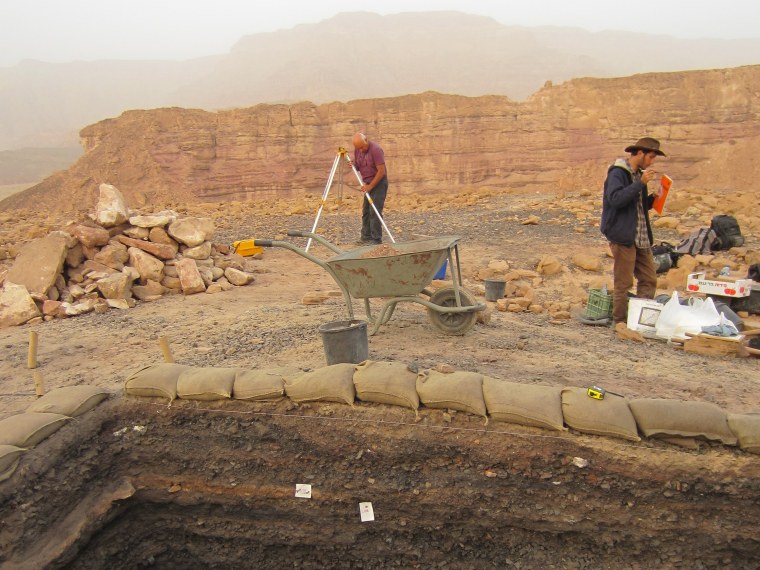
Samplings from Israel's Timna Valley have confirmed the connection between ancient copper mines and the era of the biblical King Solomon — but that doesn't necessarily mean they were "King Solomon's mines."
Instead, archaeologists say the mines were more likely to have been operated by some of Solomon's rivals, known as the Edomites.
The fresh perspective comes from an excavation conducted at a copper smelting site known as "Slaves' Hill" in the Timna Valley, in Israel's Aravah Desert. Today, the valley is part of a national park. But in ancient times, it was a copper production district, dotted with thousands of mines and dozens of smelting sites.
Just how old were those sites? That's the key question that archaeologists from Tel Aviv University, led by Erez Ben-Yosef, sought to answer.
The conventional wisdom had been that the mines dated to around the 13th century B.C., when the Egyptians held sway over the territory. But a few years ago, archaeologists used radiocarbon dating to determine that copper mines located nearby, in Jordan's Khirbat en-Nahas region, were actually operated in the 10th century B.C. — roughly during the era when King Solomon is thought to have ruled Israel.
In 2009, a team of archaeologists including Ben-Yosef found further support for that time frame at a copper-smelting camp in the Timna Valley known as "Site 30." The follow-up excavation at Slaves' Hill confirmed the connection. Ben-Yosef and his colleagues unearthed the remains of hundreds of furnaces, and layers upon layers of copper slag waste. They also found clothes, fabrics, ropes, food leavings, ceramics and metallurgical facilities.
Ten date pits and an olive pit were subjected to carbon-dating tests at the University of Oxford. The results confirmed that the camp was in operation during the 10th century B.C.
"The mines are definitely from the period of King Solomon," Ben-Yosef said in a news release. "They may help us understand the local society, which would have been invisible to us otherwise."
Ben-Yosef and his colleagues said the mines were probably operated by the Edomites, a semi-nomadic tribal confederation that numbered among Israel's biblical foes. The extent and complexity of the Slaves' Hill camp hint at a highly organized society, capable of marshaling the labor of thousands of workers in the middle of the desert, Ben-Yosef said.
"It was a society that mostly lived in tents, but still had impressive military power, since it was necessary to protect the copper mines," Ben-Yosef told the Israeli newspaper Haaretz.
Were these ever King Solomon's mines? Actually, the legends surrounding Solomon's underground riches owe more to H. Rider Haggard's 1885 novel than to the Bible or historical accounts. Ben-Yosef said the real-life copper mines were definitely part of the kingdom of Edom — but there's still a chance that Solomon exerted some control over the region at times, by virtue of military victories described in the Bible.
There's more to come: Ben-Yosef is planning another dig at Slaves' Hill early next year, and he's looking for volunteers.
More biblical archaeology:
- Return to King Solomon's Mines
- Gallery: Eight Jewish archaeological finds
- NBC News archive on biblical archaeology
Alan Boyle is NBCNews.com's science editor. Connect with the Cosmic Log community by "liking" the NBC News Science Facebook page, following @b0yle on Twitter and adding +Alan Boyle to your Google+ circles. To keep up with NBCNews.com's stories about science and space, sign up for the Tech & Science newsletter, delivered to your email in-box every weekday. You can also check out "The Case for Pluto," my book about the controversial dwarf planet and the search for new worlds.
